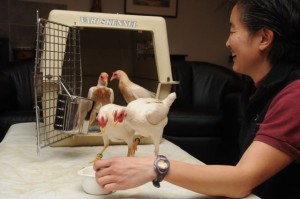Question:
I am a Psychology student who is currently enrolled in a subject that requires animal training. I saw your video on Youtube.com on training chickens. I was wondering how many days did it take you to teach the chicken those tricks? Did you use positive reinforcement? What are the chances of students like me to train a chicken on color discrimination within 20 days? I appreciate your kind consideration and time for reading this. Thank you.
Julie Gajudo
Phillipines
Answer:
Chickens can learn tricks surprisingly fast—often even faster than dogs. That’s because training of simple tasks just involves a few things—a hungry animal in a comfortable environment and a trainer with good timing. Which brings me to the first issue. If your chicken is already comfortable around you, then the training will be quick. Is she’s afraid of humans then you’ll have to spend time getting her to associate you with good things such as food. This works best if you control her food supply. For instance, if she gets most of her meal when she’s out scratching around and then you go to train her and she’s already full, your food will have little value to her. If, however, all of her food comes during training sessions, you’ll have her ready to learn tricks really fast.
Once you have her at the point where she’ll take a treat (I use scratch or crumble or other one-peck-sized food in a measuring cup with a clicker attached) immediately upon offering and will do this for 10–20 treats in a row, she’s ready to start her regular trick training sessions and the training will go fast.
Now, the trick becomes how well you’ve thought out your plan and how well you recognize what her body language is saying about her internal emotional state. For chickens, I often train the click treat association next. That is, I hold the food cup high and then click the toy clicker while remaining stationary. Then, within a split second, I deliver the food right in front of her face. Once she takes one peck of the treat, I move the food cup back to its starting point out of her reach. By doing so repeatedly, I can teach her that the click means a treat will magically appear in front of her face. By performing this pairing randomly but frequently to keep her interested in sticking near me, I can quickly train her that, when she hears the click, she can turn to me to get her treat. In my experience, the average chicken that’s comfortable in their environment and hungry takes two to three 5–10 minutes sessions a day for about 3 days.
That is, assuming that you do not make the error of having the food come too quickly and on a regular schedule. If they just hear “Click and see treat, click and see treat” with no break between click-treat pairings they may have no need to learn that a click means a treats coming. They just learn a treat’s coming pretty soon. If, however, they have a couple of seconds in between to think, “Hmmm, how do I get more treats?” and then they hear a click and see the treat, then the sound of the click is relevant. It’s also important to remain still when clicking instead of accidentally starting to deliver the treat too soon, or they will learn that the movement of your arm means treat’s coming and they won’t learn the sound.
So, how do you know when you’re ready to move on to training a trick? When your chicken immediately turns to you to get a treat when it’s facing the other direction and hears the click, then you know he understands that the click means treat.
Now, to train him to learn to peck a specific object out of a handful of objects or a specific shade of color, you first have to train him to peck the desired thing. We’ll use shapes to start. If you have a triangle, circle, and square cut out of paper and you want him to only peck the square, first, try holding the square with a tiny bit of food taped on. You’ll need to shape the behavior of pecking the object with no food on the table. You might start with click/treating looking at the object, then pecking the hand-held object, then holding the object lower, then holding the object on the table, then pecking the object on the table with your hand far away, then moving the objects around the table. Or you might start with placing a treat on the object and gradually making the treat smaller and smaller until you no longer need a treat. In any case, because chickens love to eat and can peck really fast, you can get a lot of repetitions in just 2–3 minutes. Practice in 2–3 minutes sessions with short breaks in between and with impeccable timing and you can train discrimination in just a day!
Learn more about the science of training with my lecture DVD, Pet Dogs, Problem Dogs, High Performance Dogs, available here in my online store or at Amazon.com.
Here’s a vodeo of Chicken Training Camp: https://www.youtube.com/watch?v=HPrJLkzymhM&t=2s
To participate in a chicken training camp where you practice skills that will help you improve as an animal trainer, go to “Chicken Camps by Terry Ryan” http://www.legacycanine.com/workshops/chicken-camps.html



